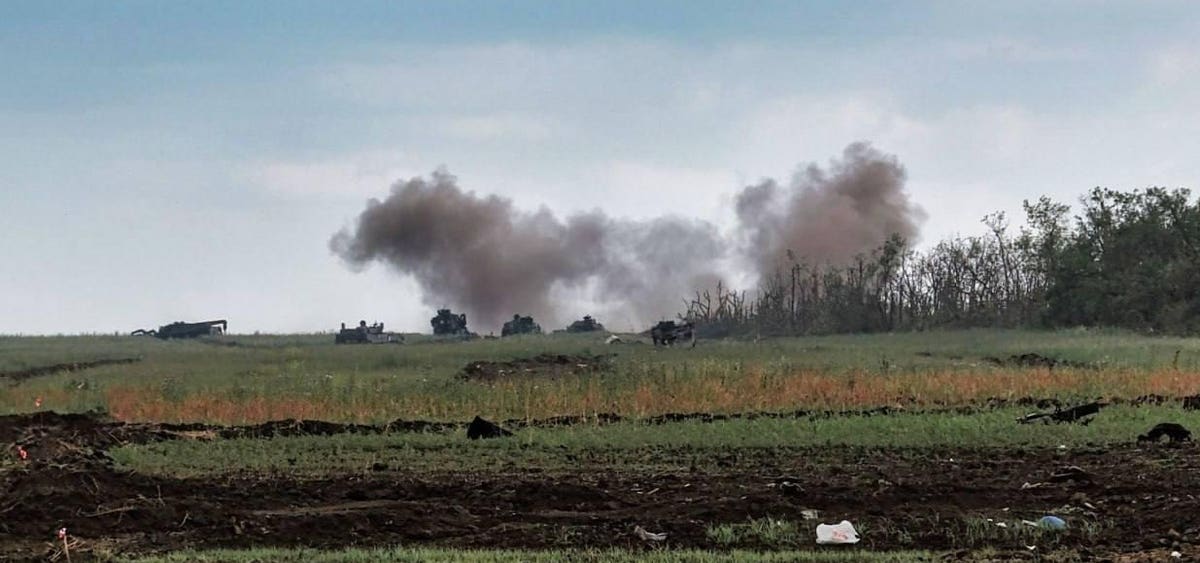Ukraine’s tiny force of six Finnish-made Leopard 2R mineclearing vehicles has the tragic distinction of suffering one of the highest loss-rates of any single vehicle community in Russia’s 17-month wider war on Ukraine.
But the survivors of the Leopard 2R platoon still are in the fight.
In a single failed assault across a Russian minefield south of Mala Tokmachka in southern Ukraine’s Zaporizhzhia Oblast on June 8, the 47th Assault Brigade—the sole operator of all six Leopard 2Rs—abandoned at least three of the two-person mineclearing vehicles, along with dozens of other vehicles.
TM-62 anti-tank mines disabled some of those vehicles south of Mala Tokmachka. Russian helicopters and artillery hit others.
The disastrous assault left the 47th Brigade with just three Leopard 2Rs, which are 69-ton, diesel-powered Leopard 2A4 tanks that Finnish firm Patria transformed into specialized engineering vehicles by removing their turrets and adding British-made mineplows. Finland only ever ordered six Leopard 2Rs, and gave all of them to Ukraine.
It was worth wondering what was left of the 47th Brigade’s engineer battalion after the debacle of June 8. In addition to losing the three Leopard 2Rs, the battalion—or a partner engineer unit from the adjacent 33rd Mechanized Brigade—also lost a German-made Wisent mineclearing vehicle and an ex-Soviet BMR mineclearer.
It now is apparent that the battalion still is intact. A video that circulated online on Saturday depicts a convoy of 47th Brigade engineering vehicles on the move in Zaporizhzhia. The convoy includes a Leopard 2R, two Soviet-style armored tractors fitted with UR-77 rocket-propelled mineclearing charges and a Wisent.
It’s a mixed platoon, but one that might reflect the way the battle-hardened engineer battalion fights, either by itself or in cooperation with sappers from adjacent brigades. Called in to clear a lane through a Russian minefield, the UR-77s obviously would go first—firing their rope-like explosive charges out to a distance of several hundred feet.
The resulting blast should begin to clear a lane. The Leopard 2R and Wisent would go next—digging their plows into the same lane and gunning their engines. Whatever mines the UR-77s missed, the plows should dig up and detonate. Tanks and infantry fighting vehicles can follow behind.
Unless, of course, something goes wrong—like it did on June 8.
A Leopard 2R and Wisent have identical mineplows from British firm Pearson Engineering. The big differences between the two types are armor protection and horsepower. A Wisent 1 has a Leopard 1 tank chassis with a 1,000-horsepower diesel engine. A Leopard 2R has a heavier and better-protected Leopard 2 tank chassis with a 1,500-horsepower engine.
A Leopard 2R can absorb more damage than a Wisent can do, so if you’re trying to clear a minefield while under fire, you’d send your Leopard 2R first. But with just three Leopard 2Rs left after June 8, 47th Brigade engineer officers might not always have that option.
Germany has donated scores of Wisents to the Ukrainian war effort—and probably could send more. There may come a day when the Leopard 2Rs are extinct, but the Wisents still are thriving.
That day isn’t today. The 47th Brigade ultimately found a way through or around the Mala Tokmachka minefield. Recovery crews last week began towing away some of the vehicles the 47th Brigade abandoned, presumably after clearing the remaining TM-62 mines.
It’s not clear how many of the damaged Leopard 2Rs are repairable. It’s possible they all are—and the 47th Brigade’s engineer battalion soon will be back to full strength with all six of the vehicles.
In the meantime, the battalion obviously is comfortable mixing and matching ex-Finnish, ex-German and ex-Soviet mineclearing vehicles. And staying in the fight.
Read the full article here





